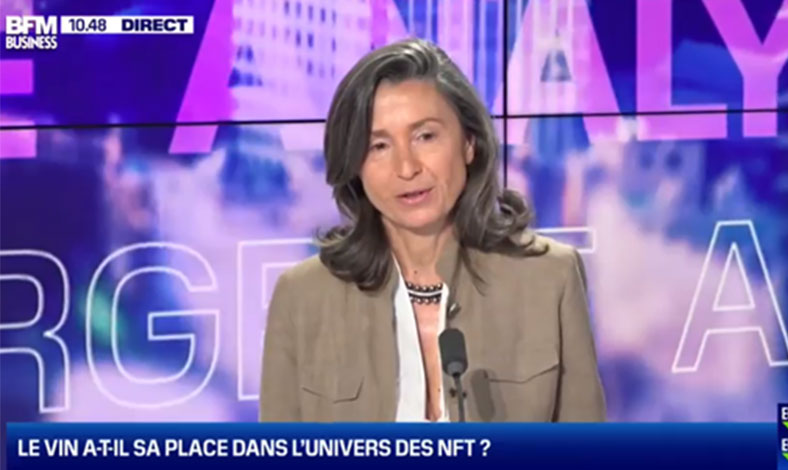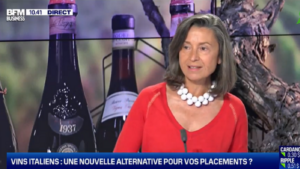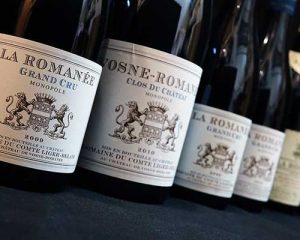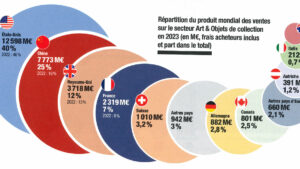
Every month, Angélique de Lencquesaing goes on the BFM Patrimoine segment to talk about investing in wine and the state of the market. This time, she spoke about the rise of NFTs and how they’ve (inevitably?) seeped into the world of wine.
Vincent Touraine: You’re regularly invited onto the programme to comment on the wine market, which has existed for several centuries already. Today, you’re going to tell us about a new development, though, the emergence of NFTs.
A de L.: Yes, that’s right, after Web 1.0 which brought the information age of Google and Yahoo etc came 2.0 and its interactive, social networks. We’re now at the stage of Web 3.0, with its decentralisation, blockchains, NFTs, crypto-currency, and the metaverse.
We’re talking about it more and more, but some of these evolutions are not so recent…
That’s right, the blockchain (a public, anonymous, and unfalsifiable register) actually dates back to 1995. Each piece of information (a transaction, for example) is stored in a block, and the pieces are linked to each other, hence the idea of a chain. All of this is stocked on a network of servers across the world. As for crypto-currency, such as bitcoin, the first examples of these appeared a decade ago. NFTs appeared in 2015, a way of linking a unique image, object, or video to an ownership title, then integrated into the blockchain. The following year saw the invention of the virtual wallet and the metaverse.
And now the world of wine is approaching the subject
There’s a whole kind of eco-system that’s been put in place over time. Owning an NFT is a way into an exclusive collectors’ club. Big brands have seen the potential in this, launching limited edition luxury products in this virtual format. Since wine has a very established place as a rare product coveted by collectors, it fits into this ‘new world’ quite naturally.
Several initiatives launched by the likes of Dom Pérignon and Angélus haven’t been so successful, though.
I think we should give them credit for opening up a bridge between the world of wine and web 3.0. Angélus sold a cask with an NFT video of the estate’s emblematic bell, and Dom Pérignon collaborated with Lady Gaga, in which the singer created a unique piece of art that adorned a jeroboam of 2005 Rosé Vintage. A whole new virtual space was created for the occasion, allowing wine lovers to acquire the NFT version of the artwork alongside the real bottle of rosé champagne.
It’s just getting started, and attracting a younger and more connected audience. Plus, these first attempts will need to be fully integrated into the 3.0 system before we see the extent of their success. Beyond the innovative marketiàng aspect, they reach a specific kind of buyer who already exists in other circles, often interacting on other social networks like Discord.
iDealwine has already made inroads into NFTs with the WineDex chip, is that right?
We’ve come into NFTs from a different angle, not really with art or a particular experience in mind (at least not to begin with), but more out of concern for assessing and authenticating wines in the context of auction sales. Fake bottles do find their way into the circuit, and some of our Asian clients were particularly worried about this. They would ask for more detail about the bottles they planned on buying, seeking more photos and more precise information.
This led to the creation of our WineDex chip, which we developed with Synvance, the first of which was attached to a bottle in 2019. To begin with, we only applied the chip to bottles worth over €1,000, now the threshold has been lowered to €500. The tag links the wine with all of its details – including its origin and its condition – which are stocked on the blockchain, and it self-destructs if removed from the bottle.
So, this is a far cry from image-based NFT campaigns..?
Yes, it wasn’t an especially glamourous idea to start with. Our aim was to be able to store 50 different assessment points for the bottle in question, providing an authentication certificate that relied on what’s known as a smart contract. The wine’s owner need only scan the chip in their WineDex app to access this certificate and all the assessment information pertaining to the wine. The link between the bottle and its WineDex chip is totally unique, and the tag cannot be placed on another bottle. It is a perfectly safe and authentifiable system. For now, the information is stocked on the iDealwine Blockchain, which is a private blockchain for now…but we don’t plan on stopping there!
How many bottles already have this WineDex chip?
We’ll soon be crossing the threshold of 10,000 bottles. 7,500 of these have already been sold, fetching a total hammer price of €11.2 million. In terms of the collectors, 1,100 now own a bottle of wine equipped with this technology, and it’s a circle that keeps growing larger.
Speaking of collections and limited editions, I saw that you’ve recently taken a new step in this domain?
Yes, we managed to launch a project linking wine, art, and technology. We’ve all seen how the art market has seen a huge boost with the arrival of NFTs and the sale of digital artwork. There are some really exciting initiatives taking place, such as the British Museum selling digital art to finance their new acquisitions.
This tech development is also becoming a bigger thing at art auctions. However, when it comes to wine, iDealwine was the first to auction bottles equipped with an NFT that carries a piece of art.
In this case, they were magnums of the Saint-Emilion cru Château Edmus, an estate that produced a special cuvée named Phi; a pure Cabernet Franc matured in a concrete egg and vinified without any added sulphur.
Each magnum has a one-of-a-kind label designed by tattoo artist Dimitri Hk. 10 bottles of a series of 20, were put up for auction, and one of them went under the hammer for €5,216.
What was its estimated price?
It was difficult to determine the price estimate! Each of the magnums had a starting price of €1, and their estimate was placed at €250. Clearly this was surpassed by a mile, since the overall hammer price for the ten bottles reached €22,413, over seven times their estimated value.
In this case, what does the NFT contain?
As well as the digital information about the bottle, there’s the unique artwork. The buyers also received a printed copy of the label in question. Plus, each top bidder received a five year storage contract with iDealwine.
So does the buyer not get their bottle? They won’t be able to drink it?
Well, that’s where the importance of the NFT comes in. If the bottle is opened, the NFT will have no market value apart from the wine’s artwork. If the bottle stays put, this is what will offer the buyer the possibility of reselling their NFT in the future. In this case, the wine doesn’t even need to move from its storage cellar.
Does this market have big potential?
The NFT market in general is estimated to be worth 41billion dollars at the moment, and J.P. Morgan has announced a potential growth to 80 billion dollars by 2025. Across the world, around 400,000 people are actively buying and trading NFTs. This system lends itself well to wine, particularly those made to be aged for many years before being uncorked. NFTs will allow bottles to change hands many times without the bottle being physically moved. This is good for the wine, and it’s better for the planet, too.
With several tech initiatives coming to fruition in the world of wine, there’s a bit of a race on. Where would you say you’re at in this race?
There are all kinds of different tech concepts being introduced into wine right now. We succeeded in launching a first step, with the creation of WineDex and its smart contracts. Auctioning the first NFTs linked directly to a bottle of wine is another big step ahead. And our global network of wine lovers is informed and connected, increasingly keen to link their passion for wine with the newest tech. I can confirm that the potential for this market is huge!
You can shop our latest wine selections here
You might also like to read:



